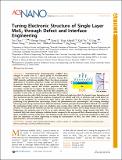| dc.contributor.author | Yin, Kedi | |
| dc.contributor.author | Ling, Xi | |
| dc.contributor.author | Xue, Jianmin | |
| dc.contributor.author | Chen, Yan | |
| dc.contributor.author | Huang, Shengxi | |
| dc.contributor.author | Ji, Xiang | |
| dc.contributor.author | Adepalli, Kiran Kumar | |
| dc.contributor.author | Wang, Xinwei | |
| dc.contributor.author | Dresselhaus, Mildred | |
| dc.contributor.author | Kong, Jing | |
| dc.contributor.author | Yildiz, Bilge | |
| dc.date.accessioned | 2019-02-11T16:08:44Z | |
| dc.date.available | 2019-02-11T16:08:44Z | |
| dc.date.issued | 2018-02 | |
| dc.date.submitted | 2017-11 | |
| dc.identifier.issn | 1936-0851 | |
| dc.identifier.issn | 1936-086X | |
| dc.identifier.uri | http://hdl.handle.net/1721.1/120317 | |
| dc.description.abstract | Transition-metal dichalcogenides (TMDs) have emerged in recent years as a special group of two-dimensional materials and have attracted tremendous attention. Among these TMD materials, molybdenum disulfide (MoS₂) has shown promising applications in electronics, photonics, energy, and electrochemistry. In particular, the defects in MoS₂ play an essential role in altering the electronic, magnetic, optical, and catalytic properties of MoS₂, presenting a useful way to engineer the performance of MoS₂. The mechanisms by which lattice defects affect the MoS₂ properties are unsettled. In this work, we reveal systematically how lattice defects and substrate interface affect MoS₂ electronic structure. We fabricated single-layer MoS₂ by chemical vapor deposition and then transferred onto Au, single-layer graphene, hexagonal boron nitride, and CeO₂ as substrates and created defects in MoS₂ by ion irradiation. We assessed how these defects and substrates affect the electronic structure of MoS₂ by performing X-ray photoelectron spectroscopy, Raman and photoluminescence spectroscopies, and scanning tunneling microscopy/spectroscopy measurements. Molecular dynamics and first-principles based simulations allowed us to conclude the predominant lattice defects upon ion irradiation and associate those with the experimentally obtained electronic structure. We found that the substrates can tune the electronic energy levels in MoS₂ due to charge transfer at the interface. Furthermore, the reduction state of CeO₂ as an oxide substrate affects the interface charge transfer with MoS₂. The irradiated MoS2 had a faster hydrogen evolution kinetics compared to the as-prepared MoS2, demonstrating the concept of defect controlled reactivity in this phase. Our findings provide effective probes for energy band and defects in MoS₂ and show the importance of defect engineering in tuning the functionalities of MoS₂ and other TMDs in electronics, optoelectronics, and electrochemistry. Keywords: hydrogen evolution reaction; ion irradiation; Raman spectroscopy; scanning tunneling microscopy; transition-metal dichalcogenides; X-ray photoelectron spectroscopy | en_US |
| dc.description.sponsorship | United States. Department of Energy. Office of Basic Energy Sciences (Award DE-SC0001088) | en_US |
| dc.description.sponsorship | National Science Foundation (U.S.) (Award 0939514) | en_US |
| dc.publisher | American Chemical Society (ACS) | en_US |
| dc.relation.isversionof | http://dx.doi.org/10.1021/ACSNANO.7B08418 | en_US |
| dc.rights | Article is made available in accordance with the publisher's policy and may be subject to US copyright law. Please refer to the publisher's site for terms of use. | en_US |
| dc.source | Other repository | en_US |
| dc.title | Tuning Electronic Structure of Single Layer MoS₂ through Defect and Interface Engineering | en_US |
| dc.type | Article | en_US |
| dc.identifier.citation | Chen, Yan et al. “Tuning Electronic Structure of Single Layer MoS₂ through Defect and Interface Engineering.” ACS Nano 12, 3 (February 2018): 2569–2579 © 2018 American Chemical Society | en_US |
| dc.contributor.department | Massachusetts Institute of Technology. Computer Science and Artificial Intelligence Laboratory | en_US |
| dc.contributor.department | Massachusetts Institute of Technology. Department of Materials Science and Engineering | en_US |
| dc.contributor.department | Massachusetts Institute of Technology. Department of Nuclear Science and Engineering | en_US |
| dc.contributor.department | Massachusetts Institute of Technology. Department of Physics | en_US |
| dc.contributor.department | Massachusetts Institute of Technology. Research Laboratory of Electronics | en_US |
| dc.contributor.mitauthor | Chen, Yan | |
| dc.contributor.mitauthor | Huang, Shengxi | |
| dc.contributor.mitauthor | Ji, Xiang | |
| dc.contributor.mitauthor | Adepalli, Kiran Kumar | |
| dc.contributor.mitauthor | Ling, Xi | |
| dc.contributor.mitauthor | Wang, Xinwei | |
| dc.contributor.mitauthor | Dresselhaus, Mildred | |
| dc.contributor.mitauthor | Kong, Jing | |
| dc.contributor.mitauthor | Yildiz, Bilge | |
| dc.relation.journal | ACS Nano | en_US |
| dc.eprint.version | Author's final manuscript | en_US |
| dc.type.uri | http://purl.org/eprint/type/JournalArticle | en_US |
| eprint.status | http://purl.org/eprint/status/PeerReviewed | en_US |
| dc.date.updated | 2019-02-01T13:18:58Z | |
| dspace.orderedauthors | Chen, Yan; Huang, Shengxi; Ji, Xiang; Adepalli, Kiran; Yin, Kedi; Ling, Xi; Wang, Xinwei; Xue, Jianmin; Dresselhaus, Mildred; Kong, Jing; Yildiz, Bilge | en_US |
| dspace.embargo.terms | N | en_US |
| dc.identifier.orcid | https://orcid.org/0000-0001-6063-023X | |
| dc.identifier.orcid | https://orcid.org/0000-0002-3618-9074 | |
| dc.identifier.orcid | https://orcid.org/0000-0001-6305-1161 | |
| dc.identifier.orcid | https://orcid.org/0000-0001-9641-1901 | |
| dc.identifier.orcid | https://orcid.org/0000-0002-1955-3081 | |
| dc.identifier.orcid | https://orcid.org/0000-0001-8492-2261 | |
| dc.identifier.orcid | https://orcid.org/0000-0003-0551-1208 | |
| dc.identifier.orcid | https://orcid.org/0000-0002-2688-5666 | |
| mit.license | PUBLISHER_POLICY | en_US |
